Beijing from the Chinese characters 北 for north and 京 for capital, means literally the “Northern Capital”.
It is the capital of the People’s Republic of China and one of the most populous cities in the world, with a population of almost 20.000,00 people. The metropolis, located in northern China, is governed as a direct-controlled municipality under the national government, with 14 urban and suburban districts and two rural counties.
Beijing is China’s second largest city by urban population after Shanghai and is the country’s political, cultural, and educational center, and home to the headquarters for most of China’s largest state-owned companies. Beijing is a major transportation hub in the national highway,expressway, railway and high-speed rail network. Beijing’s Capital International Airport is the second busiest in the world by passenger traffic.
Few cities in the world have been the political and cultural centre of an area as immense for so long. Beijing is one of the Four Great Ancient Capitals of China, and it has been the political centre of China for centuries. The city is renowned for its opulent palaces, temples, and huge stone walls and gates, and its art treasures and universities have made it a centre of culture and art in China.
Beijing has a long and rich history that dates back over 3,000 years. The Imperial residences and parks, military fortifications, walled hutongs, each are narrating to people its own story in long course of the history. Marvel at the scale and ingenuity of the Great Wall, and awe at the grandeur of the imperial Temple of Heaven. Besides all these, Beijing is a great resource of endless stories and beautiful legends, all awaits your discovery.
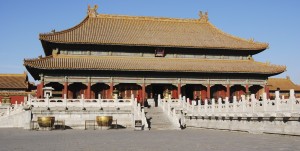 Forbidden City is the right place for you to start your Beijing tour by unveiling its mysterious face. Consisting of over 9,000 rooms and spread over 250 acres, this large palace complex was built between 1406 and 1420, but was burnt down, rebuilt, sacked and renovated countless times, so most of the architecture you can see today dates from the 18th century and on wards during the Qing Dynasty. Wear comfortable shoes as you have to walk a lot! We highly recommend going with a guide. It really is helpful to have a guide explain the stories behind the site and tell you about the important historical parts in the forbidden city. Or if you are non-group tourists, We suggest you rent multi lingual guide recorder either at Meridian Gate ( southern gate of Forbidden city ) or the Gate of Divine Prowess (Northern gate of Forbidden City) and return it when you finish your tour of Forbidden City. After you visit the Imperial Palace and go out of the Gate of Divine Prowess, you can enter into Jingshan Park, climb a bit and overlook the panorama of the Imperial Palace. In the evening, especially in summer, Forbidden City is brilliant. Colored lights from all directions lighten Meridian Gate, the Gate of Divine Prowess, turret, palace wall and other main palaces.
Forbidden City is the right place for you to start your Beijing tour by unveiling its mysterious face. Consisting of over 9,000 rooms and spread over 250 acres, this large palace complex was built between 1406 and 1420, but was burnt down, rebuilt, sacked and renovated countless times, so most of the architecture you can see today dates from the 18th century and on wards during the Qing Dynasty. Wear comfortable shoes as you have to walk a lot! We highly recommend going with a guide. It really is helpful to have a guide explain the stories behind the site and tell you about the important historical parts in the forbidden city. Or if you are non-group tourists, We suggest you rent multi lingual guide recorder either at Meridian Gate ( southern gate of Forbidden city ) or the Gate of Divine Prowess (Northern gate of Forbidden City) and return it when you finish your tour of Forbidden City. After you visit the Imperial Palace and go out of the Gate of Divine Prowess, you can enter into Jingshan Park, climb a bit and overlook the panorama of the Imperial Palace. In the evening, especially in summer, Forbidden City is brilliant. Colored lights from all directions lighten Meridian Gate, the Gate of Divine Prowess, turret, palace wall and other main palaces.
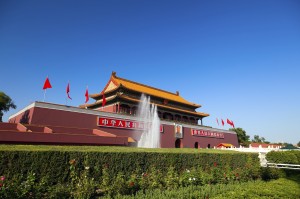 Tiananmen Square – What is the symbol of Beijing? There are various answers. But Tiananmen Square is definitely on the top list. Located in the heart of Beijing City, it is the site for massive parades and rallies, which is the largest square of this kind in the world. This was the site when in 1949, from a rostrum on Tiananmen (the Gate of Heavenly Peace), Chairman Mao proclaimed the establishment of the People’s Republic of China. Tiananmen Square is surrounded by Tiananmen ( Gate of Heaven Peace ) on its north ; the Great Hall of the People on its west, the meeting place of national people’s congress of the People’s Republic of China; on the east of Tiananmen Square is the National Museum of China, and visiting the exhibition is like reading concise China General History; there are Monument to the People’s Heroes and Chairman Mao’s Mausoleum on the south. At sunrise and sunset the raising and lowering ceremony of the Chinese National Flag is well worth the watching. The precision of the young troops is very well performed. Go there about 30 minutes early to have a good seat. Spend the time to see the people (soldiers, tourists and locals) makes the square a true highlight for the first time visitors.
Tiananmen Square – What is the symbol of Beijing? There are various answers. But Tiananmen Square is definitely on the top list. Located in the heart of Beijing City, it is the site for massive parades and rallies, which is the largest square of this kind in the world. This was the site when in 1949, from a rostrum on Tiananmen (the Gate of Heavenly Peace), Chairman Mao proclaimed the establishment of the People’s Republic of China. Tiananmen Square is surrounded by Tiananmen ( Gate of Heaven Peace ) on its north ; the Great Hall of the People on its west, the meeting place of national people’s congress of the People’s Republic of China; on the east of Tiananmen Square is the National Museum of China, and visiting the exhibition is like reading concise China General History; there are Monument to the People’s Heroes and Chairman Mao’s Mausoleum on the south. At sunrise and sunset the raising and lowering ceremony of the Chinese National Flag is well worth the watching. The precision of the young troops is very well performed. Go there about 30 minutes early to have a good seat. Spend the time to see the people (soldiers, tourists and locals) makes the square a true highlight for the first time visitors.
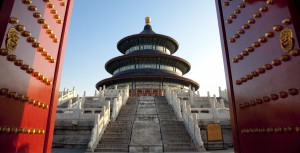 Temple of Heaven – Temple of Heaven is located in the southern part of Beijing, and has been one of the most holy places for the whole country for more than five centuries. It used as a complex of sacrificial buildings for the Ming and Qing emperors, and is the largest one in Beijing among several royal altars to Heaven, Earth, the Sun, the Moon and other deities or symbolic forces of Nature. If you go to the Temple of Heaven in the early morning, you can see groups of people practicing all types of kung fu and taiji. Many people contentedly entertain each other with music,songs or quietly playing cards. You can also practice with them if you are so inclined. This is another good activity for the jetlagged. What makes the temple unique is the century-old trees – line upon line of Chinese cypress, Chinese juniper and scholar trees. Some of the cypresses are more than 600 years old.
Temple of Heaven – Temple of Heaven is located in the southern part of Beijing, and has been one of the most holy places for the whole country for more than five centuries. It used as a complex of sacrificial buildings for the Ming and Qing emperors, and is the largest one in Beijing among several royal altars to Heaven, Earth, the Sun, the Moon and other deities or symbolic forces of Nature. If you go to the Temple of Heaven in the early morning, you can see groups of people practicing all types of kung fu and taiji. Many people contentedly entertain each other with music,songs or quietly playing cards. You can also practice with them if you are so inclined. This is another good activity for the jetlagged. What makes the temple unique is the century-old trees – line upon line of Chinese cypress, Chinese juniper and scholar trees. Some of the cypresses are more than 600 years old.
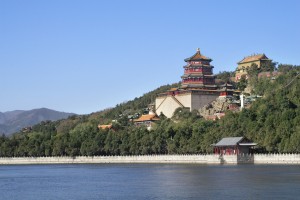 As the largest royal garden in China, Beijing’s Summer Palace is actually a parklike imperial retreat spread out over 10 square miles. The Summer Palace in northwest suburban Beijing is the largest and most complete imperial garden existing in China. Once a summer retreat for emperors, this 290-acre park is still a retreat for the tourists, who can relax here or walk around ancient pavilions, mansions, temples, bridges and huge lake. Summer Palace mainly consists of Longevity Hill (Washoushan) and Kunming Lake. Much of it is covered by Kunming Lake. With masterly design and artistic architecture and integrationg the essence of Chinese garden arts, the Summer Palace has a title of “Imperial Garden Museum”. It is an imperial garden most completely reseved with richest landscapes and concentrated buildings. The Summer Palace was added to the world cultural heritage list in 1998.
As the largest royal garden in China, Beijing’s Summer Palace is actually a parklike imperial retreat spread out over 10 square miles. The Summer Palace in northwest suburban Beijing is the largest and most complete imperial garden existing in China. Once a summer retreat for emperors, this 290-acre park is still a retreat for the tourists, who can relax here or walk around ancient pavilions, mansions, temples, bridges and huge lake. Summer Palace mainly consists of Longevity Hill (Washoushan) and Kunming Lake. Much of it is covered by Kunming Lake. With masterly design and artistic architecture and integrationg the essence of Chinese garden arts, the Summer Palace has a title of “Imperial Garden Museum”. It is an imperial garden most completely reseved with richest landscapes and concentrated buildings. The Summer Palace was added to the world cultural heritage list in 1998.
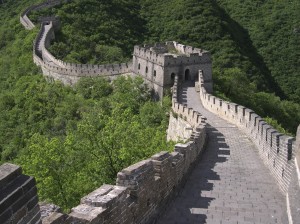 If you are in a rush, you can get the most out of your visit to Beijing by hiking one of the sections of the Great Wall. The Great Wall snaking across Beijing in its northern part is about 600 kilometers long. Along the total length of the Great Wall around Beijing, there are major eight sections including Badaling, Juyongguan, Huanghuacheng, Jiankou, Mutianyu, Gubeikou, Jinshanling, and Simatai. Most of the sections of Great Wall in Beijing are well-preserved and mainly the remains from the Ming Dynasty, an era of huge construction. For the climbing of the Great Wall, strong footwear is needed! In summer, please prepare for sunblock, sunglasses and water.
If you are in a rush, you can get the most out of your visit to Beijing by hiking one of the sections of the Great Wall. The Great Wall snaking across Beijing in its northern part is about 600 kilometers long. Along the total length of the Great Wall around Beijing, there are major eight sections including Badaling, Juyongguan, Huanghuacheng, Jiankou, Mutianyu, Gubeikou, Jinshanling, and Simatai. Most of the sections of Great Wall in Beijing are well-preserved and mainly the remains from the Ming Dynasty, an era of huge construction. For the climbing of the Great Wall, strong footwear is needed! In summer, please prepare for sunblock, sunglasses and water.
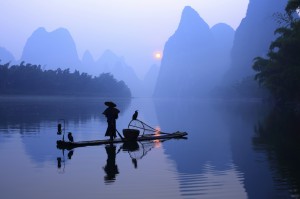 Guilin is China’s most picturesque region and has long been one of the world’s most famous travel destinations. It’s breathtaking scenery has attracted many famous poets and artists for thousands of years. Artists are able to find inspiration from the Karst mountains and the unsurpassed beauty of the Li River.Today Yangshuo’s nightlife has sprung up to keep pace with contemporary China. You can still catch a glimpse of Guilin’s yesteryears in the countryside where it has been and continues to be home to many ethnic minority groups. Every corner you look is picture postcard perfect! It is truly impossible to take a bad photo. Go ahead, immerse yourself…There is an ancient saying here – “East or west, Guilin scenery is the best”.
Guilin is China’s most picturesque region and has long been one of the world’s most famous travel destinations. It’s breathtaking scenery has attracted many famous poets and artists for thousands of years. Artists are able to find inspiration from the Karst mountains and the unsurpassed beauty of the Li River.Today Yangshuo’s nightlife has sprung up to keep pace with contemporary China. You can still catch a glimpse of Guilin’s yesteryears in the countryside where it has been and continues to be home to many ethnic minority groups. Every corner you look is picture postcard perfect! It is truly impossible to take a bad photo. Go ahead, immerse yourself…There is an ancient saying here – “East or west, Guilin scenery is the best”.
